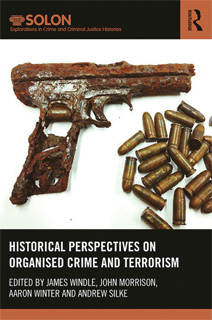Author: Edited by James Windle, John F Morrison, Aaron Winter and Andrew Silke
ISBN No: 9781317227977
Review date: 25/04/2024
No of pages: 208
Publisher: Routledge
Publisher URL:
https://www.routledge.com/Historical-Perspectives-on-Organized-Crime-and-Terrorism/Windle-Morrison-Winter-Silke/p/book/9780367482183
Year of publication: 07/12/2020
Brief:
Organised crime, and terrorism, like indeed all crime and security management, tends rather not to have a history. That makes this collection of essays most welcome, and hopefully pioneering.
An introductory chapter argues that ‘history allows debates to be driven by more realistic and in-depth analyses in historical context rather than by the anxieties of the present, whilst illuminating lessons for contemporary policy and practice’. Going into the detail of the past, as the introduction puts it, means we don’t fall into the trap ‘of looking back to a golden age when the streets were safe, the terrorists were principled freedom fighters and the gangsters were lovable rogues … and loved their mums’.
As for whether, or when or how, criminals and terrorists are connected, they may learn from one another; terrorists may run ‘in-house criminal enterprises’, to raise funds, while organised criminals may employ terror tactics, to intimidate. Both are ‘mostly rational, as opposed to mostly emotional, offences and often use similar tactics based upon violence, corruption and/or deceit to further their goals’.
The essays range across continents. To focus on the one UK chapter, by the criminologist James Windle: violence and dishonesty can be unhelpful for criminal entrepreneurs. That comes out of a chapter in this collection, that covers the fragmenting of an organised crime group in London and Essex from the late 1980s to 1995; when three of its members were murdered. Two of the group jointly ran security at a nightclub in Essex.
This was the pre-SIA days of door security. The group was (legally) providing security for licensed venues, including some of Essex and London’s top nightclubs, while taxing and protecting drug dealers, and/or selling drugs in the venues that they ‘protected’. The ‘Firm’ used debt collection and security services to extort money from businesses. Individual members also engaged in procuring prostitution, robbing drug dealers, burglary and importing of drugs. It was ‘interlocking network of small cliques’, with ‘free agents’ who drifted in and out of cliques, rather than a network with leadership or budget.
Violence might not be bad for an organised crime group; it may make for a good reputation for a physically imposing bodybuilder. The chapter suggests that ‘the threat of coercion, especially violence, may at times be important but is not an adequate substitute for social capital’. Even before the triple murder, the group was unstable, due to ‘excessive drug consumption, generally erratic behaviour, bullying of other network actors and robbery of suppliers and other drug dealers. They also failed to protect drug dealers operating in the clubs they provided security for, sold a batch of poor quality cannabis, and started to attract police attention’. What the group’s members did and their attitudes – uncontrolled due to drug over-use – had weakened their ‘social capital’: “People did not want to work or socialise with them.”
Nor did it help that a highly-publicised teenage girl died after consuming ecstasy in the club protected by the group. The chapter concludes that the group members’ bullying that provoked a lack of trust among other criminals, colleagues and associates, may have been overlooked by some, if the group still provided profitable and effective services; ‘however, poor drugs were being sold, suppliers feared being robbed, and they failed to protect drug dealers who were paying for their protection: their reputations for dishonesty were increasingly linked to a reputation of ineffectiveness’. “To function effectively, illicit networks require social capital – reciprocal and trusting relationships. Once these break down, the network can become less effective and may eventually fragment. Security and law enforcement forces could manipulate key actors’ reputations as a means of disruption.”
Also intriguing is the chapter before, on the ‘French Connection’ – a famed Hollywood film, in fact deriving from a 1962 arrest in New York, uncovering a ‘vast network of traffickers, chemists, wholesalers and dealers in heroin’ – the transatlantic heroin trade, from Europe to North America. As the historical record shows, it’d be more accurate to have named the story the ‘French-Turkish Connection’. Besides, opium grown in Turkey was processed into heroin in Lebanon and Syria.
While the ‘French Connection’ broke up in violence and arrests, after ‘a brief drought in the early 1970s, heroin from Mexican and Asian sources readily replaced stocks from Turkey in the illicit American marketplace’. In any case, demand for illegal drugs went up, regardless of counter-narcotic campaigns.
Essays in part three considers connections between organised crime, and terrorism, in the examples of Somali maritime predators; Colombian narco-terrorism, by the risk analyst Francis Gaffney; the illicit opium trade in Burma before, during and after British colonial times; and ‘blurred lines between organised crime and terrorism in Trinidad and Tobago’.










